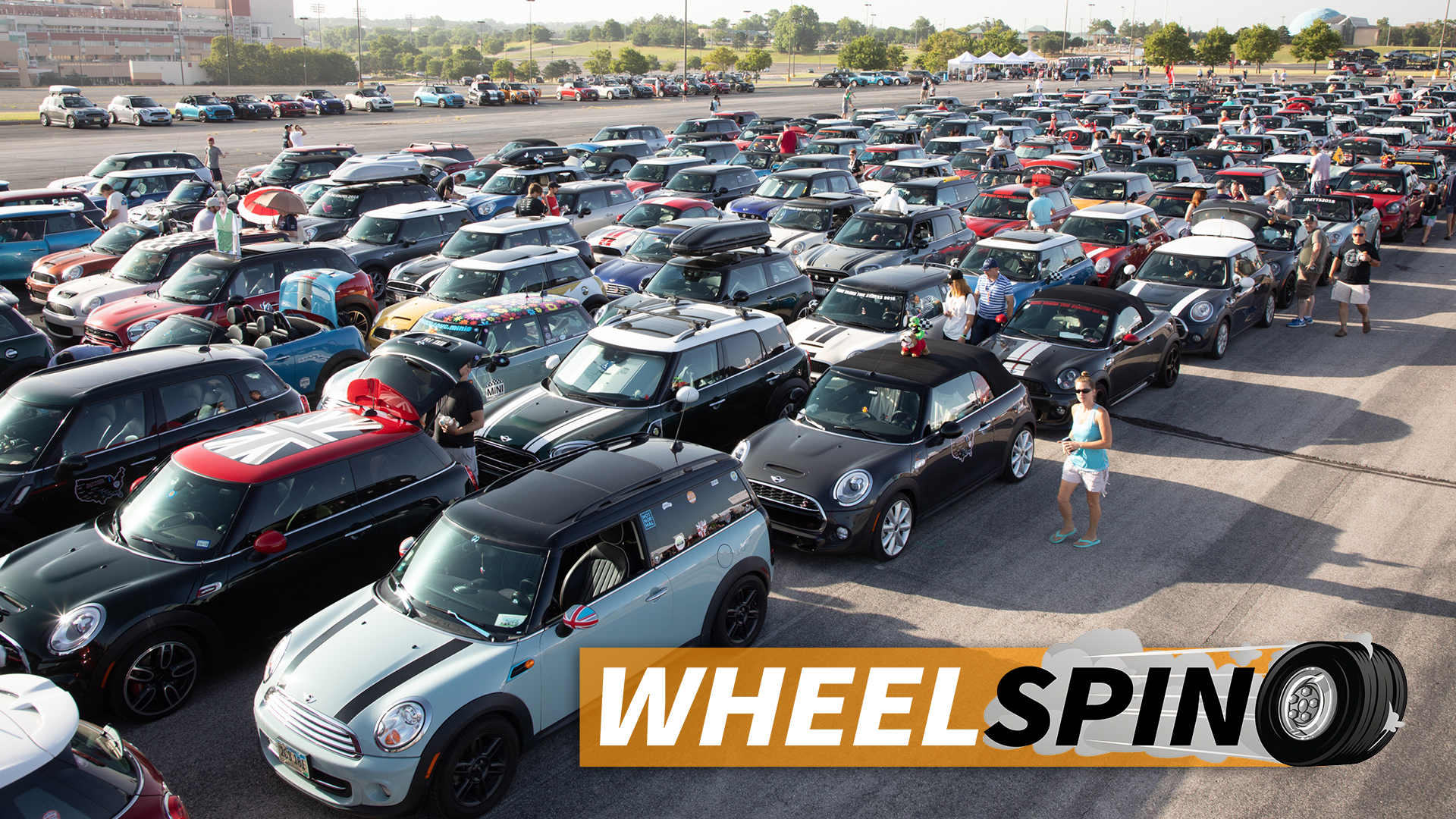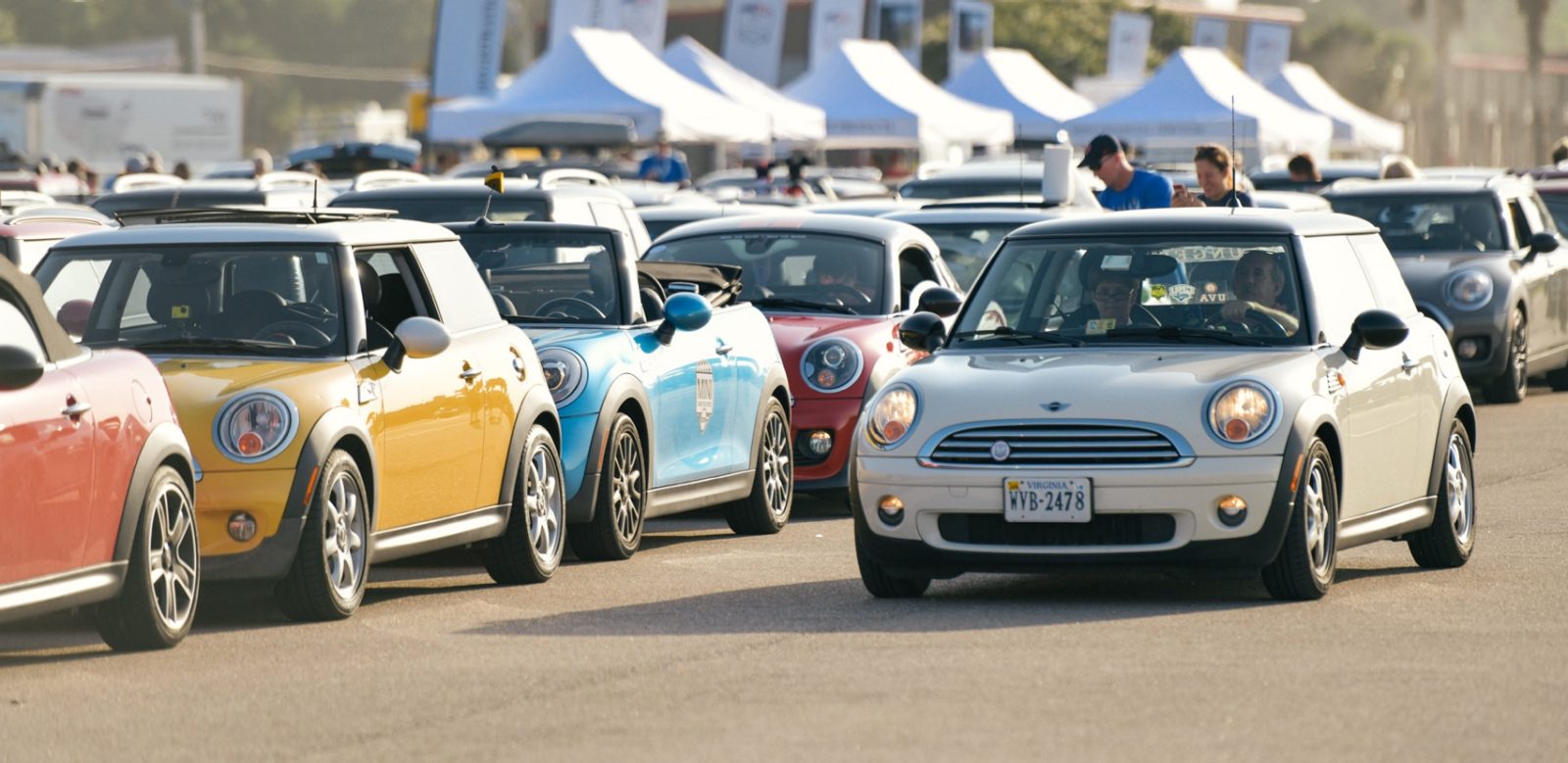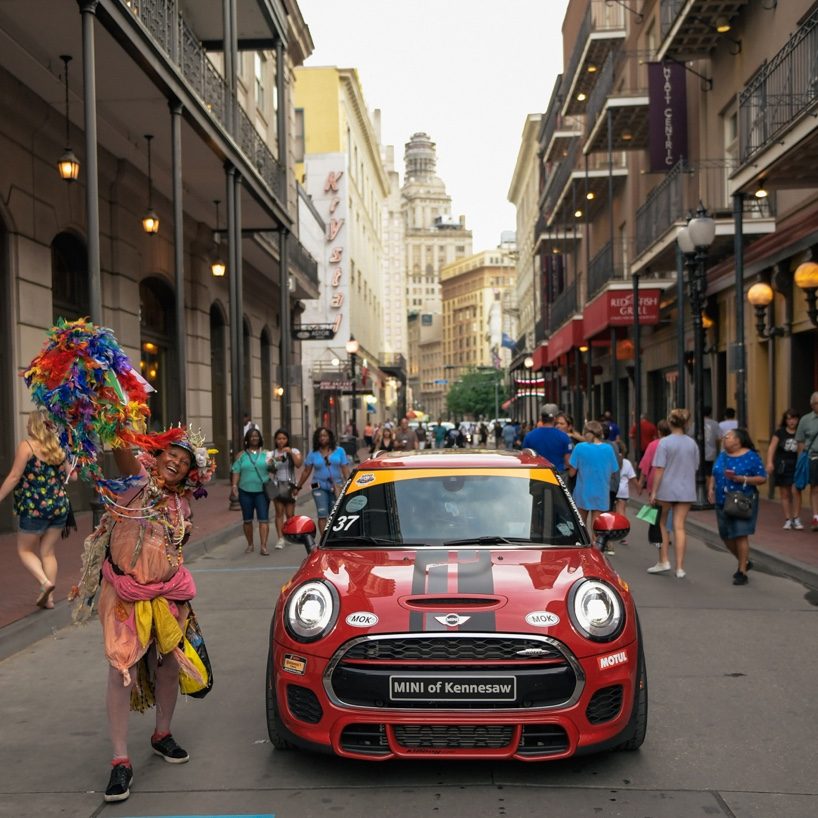

Car enthusiasts love to trash-talk Mini. Is it still around? When was the last time it came out with a new car? What happened to the Rocketman, anyway? You get the idea. But it’s a rare automaker that can gather hundreds of cars and thousands of owners for a 2,000-mile road trip down the Eastern seaboard in the middle of July.
Mini can do that. The event, Mini Takes the States, was a biennial fixture from 2006 until the world shut down. It broke its pandemic fast last month with a drive from Burlington, Vermont, to BMW’s headquarters in Spartanburg, South Carolina, including several stops along the way for merriment and to pick up stray journalists.
Rally to the Rockies, the previous MTTS event held in 2018, was a blowout. Two separate routes, one from Orlando, Florida, and the other from Portland, Oregon, saw around 1,000 Minis on the road each day, converging in Keystone, Colorado, for a three-day festival. More than 3,600 Mini owners participated.

Not everyone was back this time, but even at three-quarter size, Mini’s event leaves a mark: Impish, bug-eyed cars for miles and the people who love them: retiree couples dressed alike; younger couples in flip-flops; dogs and their humans; tuner dudes in first-gen Cooper Ses; a guy who covered his convertible’s dashboard with souvenir pins; a gen-two model in British racing green with 60 rubber ducks attached to the roof; a Batman’s-The-Joker-themed Mini; a Mini with a lift kit; a Mini in a kilt.
The whole thing would be intimidating if it wasn’t so damned adorable. Indeed, Mini Takes the States is the friendliest, most wholesome car event I’ve ever been to, and I’ve been to the annual Milk With Dinner Midwest Invitational, sponsored by No Cussing Please Cheese Curds. Did I mention Mini’s event raises money for rescue dogs? Because of course it does. It’s hard to be a cynic around these fucking people, that’s for sure.
Seeing so many human beings get along so well reminded me of a data point from years ago. I’m not sure if it’s still true, but Mini buyers in the United States once identified as members of the Republican and Democratic parties in a straight, 50-50 split. That Mini’s allure defied politics, I always felt, was a hopeful sign that humanity is as close to a hug as it is to a punch in the mouth. Then I remembered hearing the same thing about Jimmy Buffet fans and forgot the whole thing.
Still, it’s clear that lots of people of all kinds love Minis. The trouble is, Mini needs other people to love them, too.

At a Crossroads
As strong as Mini’s brand is, and as loyal as its customers may be, the company is at a crossroads. Even before the supply-chain crunch, its sales had gone flat globally. It’s backed itself into a corner, product-wise, as its name can’t—at least semantically—support the kinds of vehicles U.S. consumers buy in quantity. This is a truck country now. Mini has nothing to offer in that regard. Its largest model, the Countryman, epitomizes Mini’s needle-threading quandary: It seems to be both too large for the nameplate and too small for the segment, but nonetheless is Mini’s second biggest-selling model.
Despite affection from fans, its current designs are lost in an uncanny valley of cuteness. The taut minimalism and short overhangs that made its original models so appealing are long gone. The latest ones have a walleyed, melty look that evokes soft sculpture. Its highest-performance models, the John Cooper Works editions, are fast and have a solid, posh feel, but are missing the x-factor edginess of older models. Indeed, other than meeting up with a few thousand friends on a road trip every other year, Mini’s most exciting days appear to be behind it.

None of that matters nearly as much as what’s about to happen. Moving quicker than its parent, BMW, which announced half of its global sales will be EVs by 2030, Mini’s pledged to go all-electric by the same year. It’s already selling the electric Cooper SE, which we like, but it needs more range, although that’s reportedly coming in its next iteration.
While the EV-only prospect is disorienting to those of us who picture Minis eternally spitting fire in full send, becoming an EV company may provide the inflection Mini needs to finally break the malaise, get its designs back in spec, and elevate it to a full-line, global automaker, as business realities dictate. In the best case, Mini will seize the opportunity to rekindle the magic that once animated the brand.
Yes, magic. If you think that’s me being allowed to let my prose turn too purple, here’s a story that may change your mind.
Iconic Roots
Fifty-six years ago, somewhere in France’s Alpes-Maritimes, Paddy Hopkirk downshifted, jabbed the brake, and launched his red Mini Cooper S into a controlled drift. The tiny car pivoted in the snow and bounced across the pass a few feet, its pipsqueak front tires scrabbling. The Mini swung sideways, engine raging, before hooking up and careening down the mountain toward the next hairpin, its Lucas lamps blazing in the dusk like a tracer into the middle distance.

Wrapping up the most notorious special stage of the Monte Carlo Rally, the Col de Turini, Hopkirk and his co-driver Henry Liddon found they’d taken the lead. Bo Ljungfeldt, a Ford factory driver, had dominated nearly every other stage in a V8-powered Falcon, but the Swede couldn’t touch Hopkirk and the John Cooper-tuned Mini on the treacherous downhills. With help from a final, manic sprint through the narrow streets of Monte Carlo and race organizers’ balance-of-power formula, the Mini won outright. It would do it again in ‘65 and ‘67.
Hopkirk, who passed away earlier this year, celebrated his ‘64 win with F1 legend Juan Manuel Fangio on a Monaco balcony, glugging champagne and scooping handfuls of caviar from a tin he’d smuggled from Minsk, where the starting flag had dropped.
The next day he got a congratulatory telegram from the Beatles.

That’s the kind of mojo on which the Mini brand turns. The original 1959 BMC Mini was an economy car developed in response to the UK fuel crunch that followed the Suez Canal crisis. After a slow start, and with some help from F1 constructor Cooper, who created the world’s first hot hatch on its platform, Mini by the mid-1960s had become a pop-culture icon. Celebrities embraced it. It lent its name to UK designer Mary Quant’s Earth-shatteringly short skirt (yes, really.) Its bulldog stance and never-say-die attitude, portrayed famously in The Italian Job, helped Mini smash through class barriers and become Britain’s car of the people. Ordinary working-class folks owned and loved Minis. So did rock stars and famous actors.
Stateside Arrival
Mini was sold in the U.S. from 1960 to 1967, but only 10,000 made it into Americans’ hands; it was far too small to face down the restless diesels of our interstate highways. Still, for a car that sold in relatively small quantities, Mini was among the most recognized vehicles in the world.
Under BMW’s umbrella, the new Mini arrived in the U.S. in 2002 just as sales of large SUVs were peaking. BMW pushed the brand upmarket, where it could have more headroom on margins. Higher-end subcompacts were doing well in Europe, but in the States, the concept needed some help.

That job fell to upstart ad shop Crispin Porter + Bogusky, which created the phenomenally successful launch campaign, Let’s Motor, including a moody brochure called “The Book of Motoring” that went out to prospective customers. According to the Harvard Business Review, as CP+B’s Kerri Martin said at the time, the model for the Mini brand—which sold $25,000 cars among $15,000 competitors—was “closer to Porsche and Harley Davidson, not the [VW New] Beetle and PT Cruiser.”
They had exactly the right car to lead the charge. The initial Mini Cooper hardtop was an exciting package: a minimalist design that captured the original Mini’s essence through bulldog biomimicry, and spry performance. It staked out new, personality-driven territory in a car market prime for disruption.
That specialty-car business model, which was crucial in generating excitement for Mini’s U.S. launch, would be a difficult needle to thread over the longer term. Selected BMW dealers were spending upward of $400,000 each to add Mini shops to their lots, and were keen to recoup. With the first year’s volume capped at 20,000 cars, dealers knew they’d have to be in it for the long term, but their patience would only go so far. Over time, they would need more products to sell.
To an outsider embedded with Mini Takes The States, it’s shocking to see the range of models that wore the Mini nameplate over two decades. It’s an apt illustration of the brand’s earnest, but uneven, attempts at expanding the line. There’s the original three-door, the S version and the John Cooper Works package editions. There’s the four-door, the Clubman wagon, the Countryman crossover and its perplexing and short-lived sibling, the two-door Paceman.
There’s the two-seat roadster and coupe, which took a lot of heat for looking like a backward baseball cap; I think both have aged well. Then, there are the special editions like the Sidewalk, the new Resolute, the racy GP, and many others over the years. It’s all been part of that needle-threading that’s undoubtedly haunted product planners’ dreams: how to sustain the Mini ethos while creeping into profitable, higher-volume segments and putting more models in showrooms.
A New Avenue to Explore?
One product you won’t see at Mini Takes the States is the Cooper SE. That’s a logistical problem for now, related to the EV’s charging needs—it’s hard to take the states just 115 miles of charge at a time. As the company rolls out more electrics over the next eight years, Mini will have to find a way to make it work. After all, product planners expect EV models to add to Mini’s customer base, not cannibalize it. MTTS could become a metaphor for the best outcome in the coming phase shift: current ICE and new EV owners (and their dogs) road-tripping together.

Mini did take the opportunity at this year’s event to show journalists what a Cooper SE convertible might look like. Considering no other EV convertible exists (unless you count the old Tesla Roadster or the GMC Hummer’s removable roof panels), Mini has an opening to wedge a new attitude of fun, aspirational EVs into a market currently focused on luxury and utility.
Mini’s final series of internal combustion vehicles will arrive around 2025, with a new three-door alongside a new, Chinese-built EV hatch—the second generation of the Mini Cooper SE, which is currently in development testing. It will look similar to the standard hatch, but get a boost in range, and be built under a joint venture with Great Wall Motors. It’s likely a convertible version will follow.
The updated Countryman, arriving sometime after, will be larger than the current model to make room for a smaller EV crossover, hinted at with the latest Aceman EV concept. Mini’s tightening up its styling, too, with designers examining the original Alec Issoganis BMC Mini design, both inside and out, for hints on how to bring Mini’s original sense of purpose to its EVs.

“Mini is on a path of growth and heading towards a fully electric future,” Stefanie Wurst, Head of the Mini brand since earlier this year, said in a press release. “Our iconic Mini three-door maximizes the experience for our customers through its electrified go-kart feeling combined with digitalized touchpoints and a clear focus on sustainability with a minimal environmental footprint.”
For enthusiasts, any mention of go-karts and Mini in the same sentence is worth the lift of an eyebrow. Still, Mini is in a unique position to remake the compact EV market in its own image, at least while customers are still in the exploration phase of EV buying. It can emphasize driving dynamics, take the lead in EV motorsports, and can focus on recreational pursuits.
No one would be mad if Mini went all in, building market-sized crossovers, as long as it still invested in supporting a strong sporty car line, a la Porsche. Enthusiasts who are still coming to terms with EVs would be fine with that.
Most of all, Mini should never forget that authenticity and personality are assets, not liabilities, and lean deeper into its convictions.
Whatever its strategy will be, we can hope Mini stops threading needles and fully embraces the potential of its brand to bring together the love of motoring and the desire to own an electric vehicle in a single showroom. If not Mini, who?
Do it for Paddy.
Mike Spinelli has covered cars and car culture in print, online, and on family cable TV, which is as glamorous as premade pancake batter. Send him tips, comments, and story ideas at wheelspin@thedrive.com.